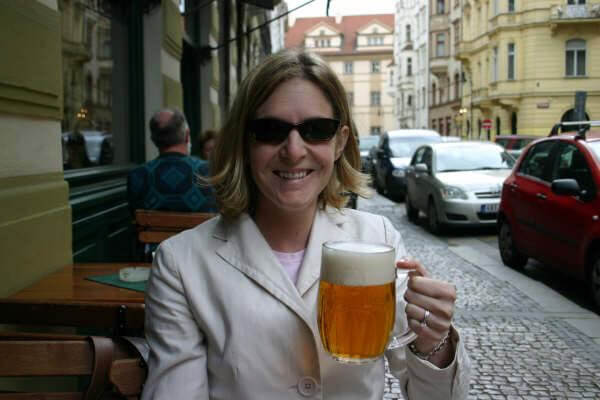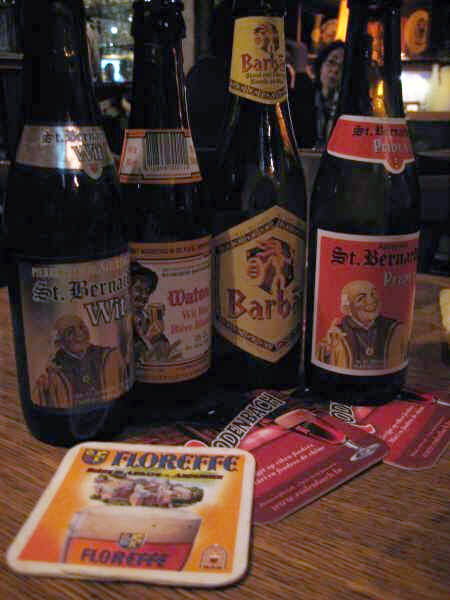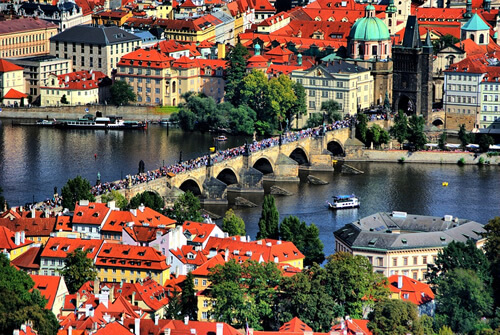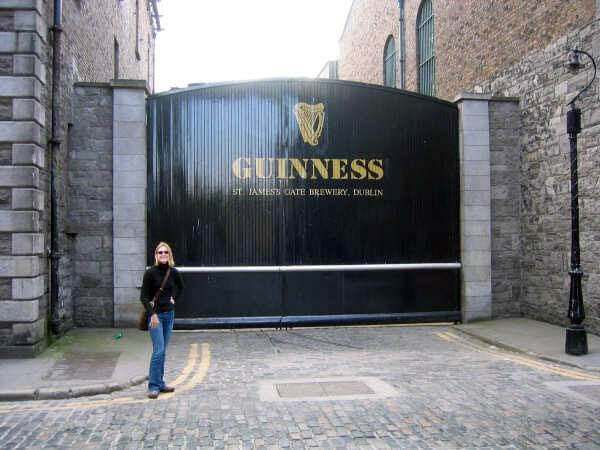Travel to Drink Beer and Ale in Europe
Take a Beer-Tasting Journey and Enjoy Europe's Finest
Article and photos by Holly Harper
 |
| The author is on a European beer-tasting tour, enjoying a Pilsner Urquell in Praha, Czech Republic. |
Can't make it to Munich? No worries: there is much more to European beer than Oktoberfest and Lederhosen. As an avid beer drinker from the micro-brew-rich Pacific Northwest, I've tasted many foamy pints. Although I wouldn't call myself a sommelier de bière, I can recommend some of Europe's best beers outside of Deutschland.
Discover Belgium's World-Renowned Breweries
 |
|
There is an enormous choice of great beer and labels in Bruges, Belgium.
|
Although it is world-renowned for its beer and chocolate, Belgium lives up to its gourmet reputation. With more than 400 local breweries producing more than 1000 beers, it's easy to be overwhelmed by the wide selection. Regardless, getting good advice from the locals behind the bar is easy.
You can head to the medieval city of Bruges — a UNESCO World Heritage site — to sample Belgian beer in a fairy-tale setting. First, go to the famous t'Brugs Beertje pub (Kemelstraat 5) to sample one of their 300 bottled delights. Tell Daisy, the proprietor, or one of her staff the flavors you prefer, and they can match your taste to a Belgian gem.
I recommend the St. Bernardus Prior 8 for a full-flavored ruby-colored beer and the St. Bernardus Abt 12 (10.5% alcohol!) for a top-of-the-line brew. But beware! A Belgian man sitting next to me recommended ordering only one of the high-alcohol "12" beers per night, or you may find yourself "dancing on the table."
Head next to Bierbrasserie Cambrinus (Philipstockstraat 19), where a wood-bound, color-coded menu helps explain each beer by its flavor, coloring, alcohol content, and ingredients. Try the Watou Wit, a wheat beer with hints of orange and coriander, followed by a Kwak ale in a puzzling and entertaining glassware. As you have now sampled four or five Belgian beers, you have probably noticed that each bottle comes with its own specific glass, especially that beer. Although it might seem like a bit of beer snobbery, the brewers designate a particular glass to help bring out the flavor of their brew.
For dessert, order the super sweet and fruity Lindeman's Framboos (raspberry) or Lindeman's Peche (peach), spontaneously fermented beers called lambic that remind you what would happen if beer, champagne, and fruit somehow fathered a love child.
Stagger home and rest. The following day, stop by the world-renowned beer shop De Bier Tempel (Philipstockstraat 7) to purchase bottles and coordinate stemware for takeaway.
Finally, it's time for a side trip into the Flemish countryside to one of Belgium's Trappist breweries. Only seven Trappist breweries exist worldwide — six in Belgium and one in the Netherlands. Trappist breweries are licensed as "Trappist" and brewed by monks in a monastery — yes, that's right, holy men making the sacred drink.
A short drive from Bruges takes you to the Abbey of Saint Sixtus of Westvleteren, where you can sample what some consider the "holy grail" of beer in the monastery café. In fact, RateBeer.com listed the Westvleteren Abt 12 as the best beer in the world! However, the beer phone reservation system can only allow the brew purchase in takeaway quantity. That's right: this beer is so rare that sales are limited to one order per month because the brewers "would like to reach as many customers as possible."
Czech Republic: The Birthplace of Pilsner
 |
|
Beautiful and lively gothic Prague in the springtime is a great place to enjoy tasting the local beer. |
Like Brugge, Prague is a city worth visiting regardless of whether you are a beer, wine, or water traveler. Most pubs in Prague are affiliated with one beer or another. For instance, if you go to a pub with a Pilsner Urquell sign in the window, it's likely the only beer sold inside. So it takes a little bar hopping to ensure you try all Prague heavyweights: Pilsner Urquell, Budvar, and Gambrinus. Try them all. All are light, clear lagers with a smooth taste, served in lovely heavy mugs for around $2. Some pubs offer a dark version of their on-tap favorite, so make sure you sample that, too.
Once you've tried all of Prague's big-time brews, it's time to try a microbrew. Stop first in the center of the old town at U Medvídků, where a great Budvar bar has a little more up its sleeve. In addition to the Budvar, try the Old Gott, a 5.2% pivo with a more full-bodied flavor than the Budvar. If you want a kick, ask for the Double Beer Primator 24°a 10% alcohol, super dark solid beer in a traditional bottle.
After you've filled your belly, it is time for a hike across town. Walk across the Charles Bridge from the Old Town, filling up your digital camera with spires, statues, and castle shots, and keep heading uphill on Uvoz to the Strahov Monastery and Library. Across the courtyard from the Strahov Library is Klasterni Pivovar Brewery (Strahovske Nadvori 301).
The Klasterni Pivovar Brewery "reopened" in 2000 after a 93-year hiatus. I don't know if it is still affiliated with the monastery next door, regardless of the location, and beer is fantastic. When you first step inside, it looks like the typical Budvar bar. Yet, the brewery also handcrafts the St. Norbert collection — an amber and a dark, and a special beer to compliment each Czech season. I visited in early spring and was pleasantly surprised with the St. Norbert Weizen. This spicy, citrusy wheat beer was a welcome respite from all of the lager.
Ireland's Rich Tradition of Stout Beers
 |
| Visiting the home of Guinness at the St. James Gate Brewery, Dublin. |
Okay, I favor the Belgians and their liquid heaven. Yet, we can't overlook Ireland and its famous black gold — Guinness. Does a Guinness taste different in Ireland? Unfortunately, I forgot to put a non-Irish Guinness in my suitcase so I could subject my husband to a blind taste test in a Dublin pub. But I can guarantee one thing — Guinness is everywhere.
Now, don't get me wrong, Guinness is fantastic. I love how an excellent Irish bartender can make a little shamrock in the head after the two-stage pour goes perfectly. I love how it settles, swirls, and feels as it goes down. I even loved the Guinness Storehouse experience in St. James Gate. But, after a few days in Dublin, I needed something a little less…well…less "Guinness."
Thank St. Patrick for The Porterhouse (16-18 Parliament Street, Temple Bar, Dublin). The Porterhouse is an Irish-owned microbrewery where all the brews are handcrafted with the utmost attention to detail: using locally grown Irish malts, selecting the finest hops, and handcrafting each beer. They serve three stouts, ales, lagers, and a seasonal beer that tastes like chocolate. Beer and chocolate combined into one drink? The taste rivals Belgium for a little pint of heaven.
Hop into The Porterhouse early to get a good seat at the bar downstairs so you don't have to wait in line to try your next brew. Try the Plain Porter first, and a chill goes down your spine as you realize that this perfect stout may give Guinness itself a run for its money. Next, try the Brainblasta, a copper-colored ale and the strongest beer on tap at 7% alcohol. Its motto: "Use it, don't abuse it." There are still seven more to try. Don't fret. The Porterhouse is open late, so sample them all!
Exploring England's Ale Legacy
A European beer tour would only be complete with a bit about England and its pubs and ales. Unlike the previously mentioned countries, England still prides itself on serving cask-conditioned ale — that is, ale brewed using traditional ingredients (water, hops, malted barley, and yeast) but left to mature in the cask.
Almost all beer is pasteurized to kill the yeast, put in an airtight container, and then pressurized to keep it from spoiling. In England, real ale isn't pasteurized or pressurized. The yeast still lives inside the beer, giving it a limited shelf life but a freshness guarantee.
Even the major players in the brewing business in England serve cask-conditioned ales — hop into your local pub and watch as the pub master literally "pulls" the pint from the cask. The head-on English ale is much less pronounced. The beer seems more "flat" than the Czech lagers and Guinness that we've already sampled precisely because the bubbles are byproducts of the natural yeast fermentation still going on in the beer, not produced by pressurization or carbonation.
Stop into any authentic pub in England and ask for a cask ale. If they don't have one, they aren't a genuine pub. On trips to London, I prefer Fuller's London Pride. This award-winning British bitter is found throughout the city. In England, many small town pubs are owned or rented from a brewery by a family who works and lives on-site. Many are affiliated with a larger brewery: You'll see a Fuller's sign outside a pub serving Fuller's ales. But keep looking for a pub with "Free House" somewhere on the sign. These pubs are not affiliated and may sell various ales and other beers.
My heart lies in Suffolk, home of the Greene King Brewery, an establishment that claims that "no other UK brewer is as committed to cask ale" as they are. The Greene King Abbot Ale is a beautiful red, amber color with toasted malt and a lightly fruity flavor. Another favorite is the Greene King IPA — an amber ale much less hoppy than many other local ales. Greene King pubs are concentrated in East Anglia but can be found in London, Cambridge, and elsewhere throughout England.
England is also peppered with microbreweries. My local favorite is Old Cannon Brewery (86 Cannon Street, Bury St. Edmunds, Suffolk). They put out the Gunner's Daughter and Blonde Bombshell — strong and flavorful English ales in an excellent pub setting serving locally sourced traditional pub grub.
And for the road tripper, England is also peppered with beer festivals! Visit the CAMRA website for an extensive listing of events where you can spend your afternoon or evening sampling locally brewed beer by the pint or the half. Small villages and large cities celebrate their English Ales at beer fests throughout the year. They are an excellent way to travel the countryside sampling a variety of good brews with hundreds of your new British mates where the admission fees go to a local charity.
Cheers!
Holly Harper is an Oregon native currently residing in Bury St. Edmunds, Suffolk, U.K. She is a traveler and avid reader.
|
